Differential Epigenetic Status and Responses to Stressors between Retinal Cybrids Cells with African versus European Mitochondrial DNA: Insights into Disease Susceptibilities
Abstract
1. Introduction
2. Materials and Methods
2.1. Cybrid Cultures
2.2. Identification of Cybrid Haplogroups
2.3. Amyloid-β Treatment of H versus L Cybrids
2.3.1. Amyloid-β Treatment of H versus L Cybrids
2.3.2. Mitochondrial Membrane Potential (ΔΨM) Assay
2.3.3. Reactive Oxygen Species (ROS) Assay
2.3.4. Cell Metabolism Assay
2.4. Sub-Lethal UV Radiation Treatment of H versus L Cybrids
2.4.1. Growth Curve Assay after UV Exposure
2.4.2. Quantitative Real-Time PCR (qRT-PCR) Analyses
2.5. Study of Epigenetics of H versus L Cybrids
2.5.1. Inhibition of Methylation in Cybrid Cultures
2.5.2. Global DNA Methylation Assay of Cybrid Cultures
2.5.3. Gene Chip Expression Assay and Statistical Analyses
2.5.4. Quantitative Real-Time PCR (qRT-PCR) Analyses
2.6. Statistical Analyses
3. Results
3.1. Comparison of the Effects of Amyloid Treatment on H and L Cybrids
3.2. Sub-Lethal UV Radiation Treatment of H versus L Cybrids
3.2.1. Comparison of Growth Curves in H and L Cybrids after UV Treatment
3.2.2. Comparison of Gene Expression Profiles in H and L Cybrids after UV Treatment
3.3. Study of Epigenetics of H versus L Cybrids
3.3.1. Elevated Levels of Global DNA Methylation in L versus H Cybrids
3.3.2. Altered Expression Levels of Methylation Genes
3.3.3. Methylation Inhibitor Studies Comparing African-L versus European-H Cybrids
3.3.4. Sequence Comparisons of H and L Cybrids for the MT-Dloop
3.4. Acetylation Studies
3.4.1. Expression of Acetylation Genes
3.4.2. Differential Expression Levels for Histone Cluster Genes in L versus H Cybrids
4. Discussion
5. Conclusions
Supplementary Materials
Author Contributions
Funding
Institutional Review Board Statement
Informed Consent Statement
Data Availability Statement
Acknowledgments
Conflicts of Interest
References
- Wallace, D.C. Diseases of the Mitochondrial DNA. Annu. Rev. Biochem. 1992, 61, 1175–1212. [Google Scholar] [CrossRef] [PubMed]
- Wallace, D.C. Mitochondrial DNA mutations in diseases of energy metabolism. J. Bioenerg. Biomembr. 1994, 26, 241–250. [Google Scholar] [CrossRef] [PubMed]
- McFarland, R.; Turnbull, D.M. Batteries not included: Diagnosis and management of mitochondrial disease. J. Intern. Med. 2009, 265, 210–228. [Google Scholar] [CrossRef]
- Bellizzi, D.; Taverna, D.; D’Aquila, P.; De Blasi, S.; De Benedictis, G. Mitochondrial DNA variability modulates mRNA and intra-mitochondrial protein levels of HSP60 and HSP75: Experimental evidence from cybrid lines. Cell Stress Chaperon- 2008, 14, 265–271. [Google Scholar] [CrossRef] [PubMed]
- Collins, D.W.; Gudiseva, H.V.; Trachtman, B.; Bowman, A.S.; Sagaser, A.; Sankar, P.; Miller-Ellis, E.; Lehman, A.; Addis, V.; O’Brien, J.M. Association of primary open-angle glaucoma with mitochondrial variants and haplogroups common in African Americans. Mol. Vis. 2016, 22, 454–471. [Google Scholar] [PubMed]
- Gallardo, M.E.; Moreno-Loshuertos, R.; López, C.; Casqueiro, M.; Silva, J.; Bonilla, F.; de Córdoba, S.R.; Enríquez, J.A. m. 6267G>A: A recurrent mutation in the human mitochondrial DNA that reduces cytochrome c oxidase activity and is associated with tumors. Hum. Mutat. 2006, 27, 575–582. [Google Scholar] [CrossRef] [PubMed]
- Kopinski, P.K.; Janssen, K.A.; Schaefer, P.M.; Trefely, S.; Perry, C.E.; Potluri, P.; Tintos-Hernandez, J.A.; Singh, L.N.; Karch, K.R.; Campbell, S.L.; et al. Regulation of nuclear epigenome by mitochondrial DNA heteroplasmy. Proc. Natl. Acad. Sci. USA 2019, 116, 16028–16035. [Google Scholar] [CrossRef]
- Czarnecka, A.M.; Bartnik, E. The Role of the Mitochondrial Genome in Ageing and Carcinogenesis. J. Aging Res. 2011, 2011, 1–10. [Google Scholar] [CrossRef]
- Chang, X.; Liu, Y.; Glessner, J.; Hou, C.; Qu, H.; Nguyen, K.; Sleiman, P.; Lee, L.; Diskin, S.J.; Maris, J.M.; et al. Identification of Mitochondrial DNA Variants Associated with Risk of Neuroblastoma. JNCI J. Natl. Cancer Inst. 2022, 114, 910–913. [Google Scholar] [CrossRef]
- Liu, M.M.; Chan, C.-C.; Tuo, J. Genetic mechanisms and age-related macular degeneration: Common variants, rare variants, copy number variations, epigenetics, and mitochondrial genetics. Hum. Genom. 2012, 6, 13. [Google Scholar] [CrossRef]
- Kenney, M.; Falatoonzadeh, P.; Atilano, S.; Chwa, M.; Caceres-del-Carpio, J.; Malik, D.; Kuppermann, B. African-origin mitochondrial DNA variants as a contributing factor to susceptibilities for diabetes and age-related diseases. Int. J. Diabetes Clin. Res. 2016, 3, 053. [Google Scholar]
- Jones, M.M.; Manwaring, N.; Wang, J.J.; Rochtchina, E.; Mitchell, P.; Sue, C.M. Mitochondrial DNA Haplogroups and Age-Related Maculopathy. Arch. Ophthalmol. 2007, 125, 1235–1240. [Google Scholar] [CrossRef]
- Mueller, E.E.; Schaier, E.; Brunner, S.M.; Eder, W.; Mayr, J.A.; Egger, S.F.; Nischler, C.; Oberkofler, H.; Reitsamer, H.A.; Patsch, W.; et al. Mitochondrial Haplogroups and Control Region Polymorphisms in Age-Related Macular Degeneration: A Case-Control Study. PLoS ONE 2012, 7, e30874. [Google Scholar] [CrossRef]
- Pennington, P.M.; Messenger, L.A.; Reina, J.; Juárez, J.G.; Lawrence, G.G.; Dotson, E.M.; Llewellyn, M.S.; Cordón-Rosales, C. The Chagas disease domestic transmission cycle in Guatemala: Parasite-vector switches and lack of mitochondrial co-diversification between Triatoma dimidiata and Trypanosoma cruzi subpopulations suggest non-vectorial parasite dispersal across the Motagua valley. Acta Trop. 2015, 151, 80–87. [Google Scholar] [CrossRef]
- Swerdlow, R.H.; Hui, D.; Chalise, P.; Sharma, P.; Wang, X.; Andrews, S.J.; Pa, J.; Mahnken, J.D.; Morris, J.; Wilkins, H.M.; et al. Exploratory analysis of mtDNA haplogroups in two Alzheimer’s longitudinal cohorts. Alzheimer’s Dement. 2020, 16, 1164–1172. [Google Scholar] [CrossRef]
- Antonyová, V.; Kejík, Z.; Brogyányi, T.; Kaplánek, R.; Pajková, M.; Talianová, V.; Hromádka, R.; Masařík, M.; Sýkora, D.; Mikšátková, L.; et al. Role of mtDNA disturbances in the pathogenesis of Alzheimer’s and Parkinson’s disease. DNA Repair 2020, 91–92, 102871. [Google Scholar] [CrossRef]
- Shityakov, S.; Skorb, E.V.; Förster, C.Y.; Dandekar, T. Scaffold Searching of FDA and EMA-Approved Drugs Identifies Lead Candidates for Drug Repurposing in Alzheimer’s Disease. Front. Chem. 2021, 9. [Google Scholar] [CrossRef]
- Bustamante, J.G.; Zaidi, S.R.H. Amyloidosis; StatPearls: Treasure Island, FL, USA, 2022. [Google Scholar]
- Al Adem, K.; Shanti, A.; Srivastava, A.; Homouz, D.; Thomas, S.A.; Khair, M.; Stefanini, C.; Chan, V.; Kim, T.Y.; Lee, S. Linking Alzheimer’s Disease and Type 2 Diabetes: Characterization and Inhibition of Cytotoxic Aβ and IAPP Hetero-Aggregates. Front. Mol. Biosci. 2022, 9, 842582. [Google Scholar] [CrossRef]
- Kawecki, G.E.; King, K.M.; Cramer, N.A.; Bevan, D.R.; Brown, A.M. Simulations of cross-amyloid aggregation of amyloid-β and islet amyloid polypeptide fragments. Biophys. J. 2022, 121, 2002–2013. [Google Scholar] [CrossRef]
- Wang, D.; Chen, F.; Han, Z.; Yin, Z.; Ge, X.; Lei, P. Relationship Between Amyloid-β Deposition and Blood-Brain Barrier Dysfunction in Alzheimer’s Disease. Front. Cell. Neurosci. 2021, 15, 695479. [Google Scholar] [CrossRef]
- Ashok, A.; Singh, N.; Chaudhary, S.; Bellamkonda, V.; Kritikos, A.E.; Wise, A.S.; Rana, N.; McDonald, D.; Ayyagari, R. Retinal Degeneration and Alzheimer’s Disease: An Evolving Link. Int. J. Mol. Sci. 2020, 21, 7290. [Google Scholar] [CrossRef] [PubMed]
- Parnetti, L.; Biscetti, L.; Luchetti, E.; Vergaro, A.; Menduno, P.; Cagini, C. Associations of Alzheimer rsquo s disease with macular degeneration. Front. Biosci. 2017, 9, 174–191. [Google Scholar] [CrossRef]
- Ohno-Matsui, K. Parallel findings in age-related macular degeneration and Alzheimer’s disease. Prog. Retin. Eye Res. 2011, 30, 217–238. [Google Scholar] [CrossRef] [PubMed]
- Arnold, S.E.; Arvanitakis, Z.; Macauley-Rambach, S.L.; Koenig, A.M.; Wang, H.-Y.; Ahima, R.S.; Craft, S.; Gandy, S.; Buettner, C.; Stoeckel, L.E.; et al. Brain insulin resistance in type 2 diabetes and Alzheimer disease: Concepts and conundrums. Nat. Rev. Neurol. 2018, 14, 168–181. [Google Scholar] [CrossRef] [PubMed]
- Hoyer, S. Is sporadic Alzheimer disease the brain type of non-insulin dependent diabetes mellitus? A challenging hypothesis. J. Neural Transm. 1998, 105, 415–422. [Google Scholar] [CrossRef] [PubMed]
- Lin, T.-S.; Rajagopalan, R.; Shen, Y.; Park, S.; Poreddy, A.R.; Asmelash, B.; Karwa, A.S.; Taylor, J.-S.A. Roles of Free Radicals in Type 1 Phototherapeutic Agents: Aromatic Amines, Sulfenamides, and Sulfenates. J. Phys. Chem. A 2013, 117, 5454–5462. [Google Scholar] [CrossRef] [PubMed]
- Malik, D.; Hsu, T.; Falatoonzadeh, P.; Caceres-del-Carpio, J.; Tarek, M.; Chwa, M.; Atilano, S.R.; Ramirez, C.; Nesburn, A.B.; Boyer, D.S.; et al. Human retinal transmitochondrial cybrids with J or H mtDNA haplogroups respond differently to ultraviolet radiation: Implications for retinal diseases. PLoS ONE 2014, 9, e99003. [Google Scholar] [CrossRef][Green Version]
- Patel, T.H.; Norman, L.; Chang, S.; Abedi, S.; Liu, C.; Chwa, M.; Atilano, S.R.; Thaker, K.; Lu, S.; Jazwinski, S.M.; et al. European mtDNA Variants Are Associated with Differential Responses to Cisplatin, an Anticancer Drug: Implications for Drug Resistance and Side Effects. Front. Oncol. 2019, 9, 640. [Google Scholar] [CrossRef]
- Thaker, K.; Chwa, M.; Atilano, S.R.; Coskun, P.; Cáceres-Del-Carpio, J.; Udar, N.; Boyer, D.S.; Jazwinski, S.M.; Miceli, M.V.; Nesburn, A.B.; et al. Increased expression of ApoE and protection from amyloid-beta toxicity in transmitochondrial cybrids with haplogroup K mtDNA. Neurobiol. Dis. 2016, 93, 64–77. [Google Scholar] [CrossRef]
- Kenney, M.C.; Chwa, M.; Atilano, S.R.; Falatoonzadeh, P.; Ramirez, C.; Malik, D.; Tarek, M.; Del Carpio, J.C.; Nesburn, A.B.; Boyer, D.S.; et al. Molecular and bioenergetic differences between cells with African versus European inherited mitochondrial DNA haplogroups: Implications for population susceptibility to diseases. Biochim. Biophys. Acta 2014, 1842, 208–219. [Google Scholar] [CrossRef]
- Dolinko, A.H.; Chwa, M.; Atilano, S.R.; Kenney, M.C. African and Asian Mitochondrial DNA Haplogroups Confer Resistance Against Diabetic Stresses on Retinal Pigment Epithelial Cybrid Cells In Vitro. Mol. Neurobiol. 2019, 57, 1636–1655. [Google Scholar] [CrossRef]
- Smiraglia, D.; Kulawiec, M.; Bistulfi, G.L.; Ghoshal, S.; Singh, K.K. A novel role for mitochondria in regulating epigenetic modifications in the nucleus. Cancer Biol. Ther. 2008, 7, 1182–1190. [Google Scholar] [CrossRef]
- Naviaux, R.K. Mitochondrial control of epigenetics. Cancer Biol. Ther. 2008, 7, 1191–1193. [Google Scholar] [CrossRef]
- Wallace, D.C.; Fan, W. Energetics, epigenetics, mitochondrial genetics. Mitochondrion 2010, 10, 12–31. [Google Scholar] [CrossRef]
- Bellizzi, D.; D’Aquila, P.; Scafone, T.; Giordano, M.; Riso, V.; Riccio, A.; Passarino, G. The Control Region of Mitochondrial DNA Shows an Unusual CpG and Non-CpG Methylation Pattern. DNA Res. 2013, 20, 537–547. [Google Scholar] [CrossRef]
- Morris, M.J.; Hesson, L.B.; Youngson, N.A. Non-CpG methylation biases bisulphite PCR towards low or unmethylated mitochondrial DNA: Recommendations for the field. Environ. Epigenet. 2020, 6, dvaa001. [Google Scholar] [CrossRef]
- Nashine, S.; Nesburn, A.B.; Kuppermann, B.D.; Kenney, M.C. Age-related macular degeneration (AMD) mitochondria modulate epigenetic mechanisms in retinal pigment epithelial cells. Exp. Eye Res. 2019, 189, 107701. [Google Scholar] [CrossRef]
- Vithayathil, S.A.; Ma, Y.; Kaipparettu, B.A. Transmitochondrial Cybrids: Tools for Functional Studies of Mutant Mitochondria. In Mitochondrial Disorders; Humana Press: Totowa, NJ, USA, 2011; Volume 837, pp. 219–230. [Google Scholar] [CrossRef]
- Atilano, S.R.; Malik, D.; Chwa, M.; Cáceres-Del-Carpio, J.; Nesburn, A.B.; Boyer, D.S.; Kuppermann, B.D.; Jazwinski, S.M.; Miceli, M.V.; Wallace, D.C.; et al. Mitochondrial DNA variants can mediate methylation status of inflammation, angiogenesis and signaling genes. Hum. Mol. Genet. 2015, 24, 4491–4503. [Google Scholar] [CrossRef]
- Cortés-Pereira, E.; Fernández-Tajes, J.; Fernandez-Moreno, M.; Mosquera, M.E.V.; Relaño, S.; Ramos-Louro, P.; Durán-Sotuela, A.; Dalmao-Fernández, A.; Oreiro, N.; Blanco, F.J.; et al. Differential Association of Mitochondrial DNA Haplogroups J and H With the Methylation Status of Articular Cartilage: Potential Role in Apoptosis and Metabolic and Developmental Processes. Arthritis Rheumatol. 2019, 71, 1191–1200. [Google Scholar] [CrossRef] [PubMed]
- Hatzfeld, J.J.; LaVeist, T.A.; Gaston-Johansson, F.G. Racial/Ethnic Disparities in the Prevalence of Selected Chronic Diseases Among US Air Force Members, 2008. Prev. Chronic Dis. 2012, 9, E112. [Google Scholar] [CrossRef]
- Mensah, G.A.; Mokdad, A.H.; Ford, E.S.; Greenlund, K.J.; Croft, J.B. State of Disparities in Cardiovascular Health in the United States. Circulation 2005, 111, 1233–1241. [Google Scholar] [CrossRef] [PubMed]
- Kurian, A.K.; Cardarelli, K.M. Racial and ethnic differences in cardiovascular disease risk factors: A systematic review. Ethn. Dis. 2007, 17. [Google Scholar]
- Feldman, C.H.; Hiraki, L.T.; Liu, J.; Fischer, M.A.; Solomon, D.H.; Alarcón, G.S.; Winkelmayer, W.C.; Costenbader, K.H. Epidemiology and sociodemographics of systemic lupus erythematosus and lupus nephritis among US adults with Medicaid coverage, 2000-2004. Arthritis Care Res. 2012, 65, 753–763. [Google Scholar] [CrossRef]
- Borschuk, A.P.; Everhart, R.S. Health disparities among youth with type 1 diabetes: A systematic review of the current literature. Fam. Syst. Health 2015, 33, 297–313. [Google Scholar] [CrossRef]
- Peek, M.E.; Cargill, A.; Huang, E.S. Diabetes health disparities: A systematic review of health care interventions. Med. Care Res. Rev. 2007, 64, 101s–156s. [Google Scholar]
- Chomyn, A. [29] Platelet-Mediated Transformation of Human Mitochondrial DNA-Less Cells; Academic Press: Cambridge, MA, USA, 1996; Volume 264, pp. 334–339. [Google Scholar] [CrossRef]
- Kenney, M.C.; Chwa, M.; Atilano, S.R.; Falatoonzadeh, P.; Ramirez, C.; Malik, D.; Tarek, M.; Caceres-del-Carpio, J.; Nesburn, A.B.; Boyer, D.S.; et al. Inherited mitochondrial DNA variants can affect complement, inflammation and apoptosis pathways: Insights into mitochondrial-nuclear interactions. Hum. Mol. Genet. 2014, 23, 3537–3551. [Google Scholar] [CrossRef]
- Dou, T.; Shen, M.; Ma, M.; Qu, L.; Li, Y.; Hu, Y.; Lu, J.; Guo, J.; Wang, X.; Wang, K. Genetic architecture and candidate genes detected for chicken internal organ weight with a 600 K single nucleotide polymorphism array. Asian-Australas. J. Anim. Sci. 2019, 32, 341–349. [Google Scholar] [CrossRef]
- Ebeling, M.C.; Geng, Z.; Kapphahn, R.J.; Roehrich, H.; Montezuma, S.R.; Dutton, J.R.; Ferrington, D.A. Impaired Mitochondrial Function in iPSC-Retinal Pigment Epithelium with the Complement Factor H Polymorphism for Age-Related Macular Degeneration. Cells 2021, 10, 789. [Google Scholar] [CrossRef]
- Chestnut, B.A.; Chang, Q.; Price, A.; Lesuisse, C.; Wong, M.; Martin, L.J. Epigenetic Regulation of Motor Neuron Cell Death through DNA Methylation. J. Neurosci. 2011, 31, 16619–16636. [Google Scholar] [CrossRef]
- Ratnapriya, R.; Chew, E.Y. Age-related macular degeneration-clinical review and genetics update. Clin. Genet. 2013, 84, 160–166. [Google Scholar] [CrossRef]
- Marmorstein, L.Y.; Munier, F.L.; Arsenijevic, Y.; Schorderet, D.F.; McLaughlin, P.J.; Chung, D.; Traboulsi, E.; Marmorstein, A.D. Aberrant accumulation of EFEMP1 underlies drusen formation in Malattia Leventinese and age-related macular degeneration. Proc. Natl. Acad. Sci. USA 2002, 99, 13067–13072. [Google Scholar] [CrossRef] [PubMed]
- Schwartz, S.; Hampton, B.; Kovach, J.; Brantley, M. Genetics and age-related macular degeneration: A practical review for the clinician. Clin. Ophthalmol. 2016, 10, 1229–1235. [Google Scholar] [CrossRef] [PubMed]
- DeAngelis, M.M.; Owen, L.A.; Morrison, M.A.; Morgan, D.J.; Li, M.; Shakoor, A.; Vitale, A.; Iyengar, S.; Stambolian, D.; Kim, I.K.; et al. Genetics of age-related macular degeneration (AMD). Hum. Mol. Genet. 2017, 26, R45–R50. [Google Scholar] [CrossRef] [PubMed]
- Boyer, D.S.; Schmidt-Erfurth, U.; Campagne, M.V.L.; Henry, E.C.; Brittain, C. The pathophysiology of geographic atrophy secondary to age-related macular degeneration and the complement pathway as a therapeutic target. Retina 2017, 37, 819–835. [Google Scholar] [CrossRef]
- Sánchez-Navarro, A.; Pérez-Villalva, R.; Murillo-de-Ozores, A.R.; Martínez-Rojas, M.; Rodríguez-Aguilera, J.R.; González, N.; Castañeda-Bueno, M.; Gamba, G.; Recillas-Targa, F.; Bobadilla, N.A. Vegfa promoter gene hypermethylation at HIF1α binding site is an early contributor to CKD progression after renal ischemia. Sci. Rep. 2021, 11, 8769. [Google Scholar] [CrossRef] [PubMed]
- Pisani, F.; Cammalleri, M.; Monte, M.D.; Locri, F.; Mola, M.G.; Nicchia, G.P.; Frigeri, A.; Bagnoli, P.; Svelto, M. Potential role of the methylation of VEGF gene promoter in response to hypoxia in oxygen-induced retinopathy: Beneficial effect of the absence of AQP4. J. Cell. Mol. Med. 2017, 22, 613–627. [Google Scholar] [CrossRef]
- Korbecki, J.; Gąssowska-Dobrowolska, M.; Wójcik, J.; Szatkowska, I.; Barczak, K.; Chlubek, M.; Baranowska-Bosiacka, I. The Importance of CXCL1 in Physiology and Noncancerous Diseases of Bone, Bone Marrow, Muscle and the Nervous System. Int. J. Mol. Sci. 2022, 23, 4205. [Google Scholar] [CrossRef]
- Al Sarakbi, W.; Sasi, W.; Jiang, W.G.; Roberts, T.; Newbold, R.F.; Mokbel, K. The mRNA expression of SETD2 in human breast cancer: Correlation with clinico-pathological parameters. BMC Cancer 2009, 9, 290. [Google Scholar] [CrossRef]
- Zhou, Y.; Zheng, X.; Xu, B.; Deng, H.; Chen, L.; Jiang, J. Histone methyltransferase SETD2 inhibits tumor growth via suppressing CXCL1-mediated activation of cell cycle in lung adenocarcinoma. Aging 2020, 12, 25189–25206. [Google Scholar] [CrossRef]
- Ali, M.M.; Naquiallah, D.; Qureshi, M.; Mirza, M.I.; Hassan, C.; Masrur, M.; Bianco, F.M.; Frederick, P.; Cristoforo, G.P.; Gangemi, A.; et al. DNA methylation profile of genes involved in inflammation and autoimmunity correlates with vascular function in morbidly obese adults. Epigenetics 2021, 17, 93–109. [Google Scholar] [CrossRef]
- Qin, W.; Brands, X.; Van’t Veer, C.; de Vos, F.A.; Sirard, J.C.; Roelofs, J.J.T.H.; Scicluna, B.P.; van der Poll, T. Bronchial epithelial DNA methyltransferase 3b dampens pulmonary immune responses during Pseudomonas aeruginosa infection. PLoS Pathog. 2021, 17, e1009491. [Google Scholar] [CrossRef] [PubMed]
- Long, C.; Lai, Y.; Li, J.; Huang, J.; Zou, C. LPS promotes HBO1 stability via USP25 to modulate inflammatory gene transcription in THP-1 cells. Biochim. Biophys. Acta 2018, 1861, 773–782. [Google Scholar] [CrossRef] [PubMed]
- Duong, C.V.; Yacqub-Usman, K.; Emes, R.; Clayton, R.N.; Farrell, W.E. The EFEMP1 Gene: A Frequent Target for Epigenetic Silencing in Multiple Human Pituitary Adenoma Subtypes. Neuroendocrinology 2013, 98, 200–211. [Google Scholar] [CrossRef]
- Devaney, J.; Wang, S.; Furbert-Harris, P.; Apprey, V.; Ittmann, M.; Wang, B.-D.; Olender, J.; Lee, N.; Kwabi-Addo, B. Genome-wide differentially methylated genes in prostate cancer tissues from African-American and Caucasian men. Epigenetics 2015, 10, 319–328. [Google Scholar] [CrossRef]
- Coit, P.; Yalavarthi, S.; Ognenovski, M.; Zhao, W.; Hasni, S.; Wren, J.; Kaplan, M.J.; Sawalha, A.H. Epigenome profiling reveals significant DNA demethylation of interferon signature genes in lupus neutrophils. J. Autoimmun. 2015, 58, 59–66. [Google Scholar] [CrossRef]
- Weber, M.; Hellmann, I.; Stadler, M.B.; Ramos, L.; Pääbo, S.; Rebhan, M.; Schübeler, D. Distribution, silencing potential and evolutionary impact of promoter DNA methylation in the human genome. Nat. Genet. 2007, 39, 457–466. [Google Scholar] [CrossRef] [PubMed]
- Wassenegger, M. RNA-directed DNA methylation. Plant Mol. Biol. 2000, 43, 203–220. [Google Scholar] [CrossRef]
- Amado, F.; Barros, A.; Azevedo, A.L.; Vitorino, R.; Ferreira, R. An integrated perspective and functional impact of the mitochondrial acetylome. Expert Rev. Proteom. 2014, 11, 383–394. [Google Scholar] [CrossRef]
- Hyland, E.M.; Cosgrove, M.S.; Molina, H.; Wang, D.; Pandey, A.; Cottee, R.J.; Boeke, J.D. Insights into the role of histone H3 and histone H4 core modifiable residues in Saccharomyces cerevisiae. Mol. Cell. Biol. 2005, 25, 10060–10070. [Google Scholar] [CrossRef]
- Garcia, B.A.; Hake, S.B.; Diaz, R.L.; Kauer, M.; Morris, S.A.; Recht, J.; Shabanowitz, J.; Mishra, N.; Strahl, B.D.; Allis, C.D.; et al. Organismal Differences in Post-translational Modifications in Histones H3 and H4. J. Biol. Chem. 2007, 282, 7641–7655. [Google Scholar] [CrossRef]
- Hervás-Corpión, I.; Gallardo-Orihuela, A.; Catalina-Fernández, I.; Iglesias-Lozano, I.; Soto-Torres, O.; Geribaldi-Doldán, N.; Domínguez-García, S.; Luna-García, N.; Romero-García, R.; Mora-López, F.; et al. Potential Diagnostic Value of the Differential Expression of Histone H3 Variants between Low- and High-Grade Gliomas. Cancers 2021, 13, 5261. [Google Scholar] [CrossRef] [PubMed]
- Zheng, Y.; Chi, S.; Li, C. Identification of potential gene drivers of cutaneous squamous cell carcinoma: Analysis of microarray data. Medicine 2020, 99, e22257. [Google Scholar] [CrossRef] [PubMed]
- Noblejas-López, M.D.M.; Jiménez, C.N.; García, S.M.; Pérez-Peña, J.; Nuncia, M.; Andrés-Pretel, F.; Galan-Moya, E.M.; Amir, E.; Pandiella, A.; Győrffy, B.; et al. Expression of MHC class I, HLA-A and HLA-B identifies immune-activated breast tumors with favorable outcome. OncoImmunology 2019, 8, e1629780. [Google Scholar] [CrossRef] [PubMed]
- Liu, S.; Shi, J.; Liu, Y.; Wang, L.; Zhang, J.; Huang, Y.; Chen, Z.; Yang, J. Analysis of mRNA expression differences in bladder cancer metastasis based on TCGA datasets. J. Int. Med. Res. 2021, 49. [Google Scholar] [CrossRef]
- Xiang, F.; Li, L.; Lin, J.; Li, S.; Peng, G. Network Pharmacology and Bioinformatics Methods Reveal the Mechanism of Zao-Jiao-Ci in the Treatment of LSCC. J. Oncol. 2021, 2021, 1–15. [Google Scholar] [CrossRef]
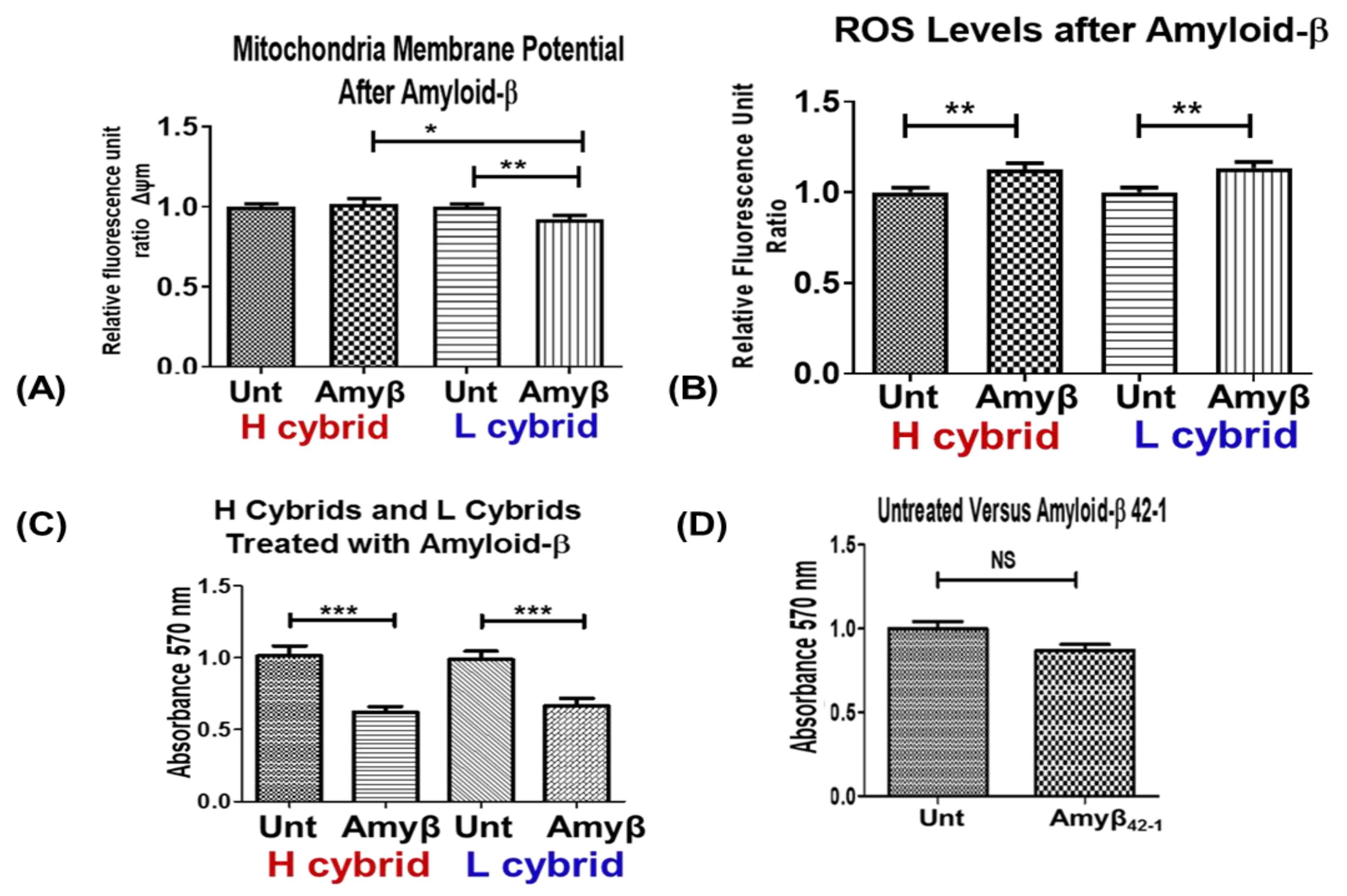
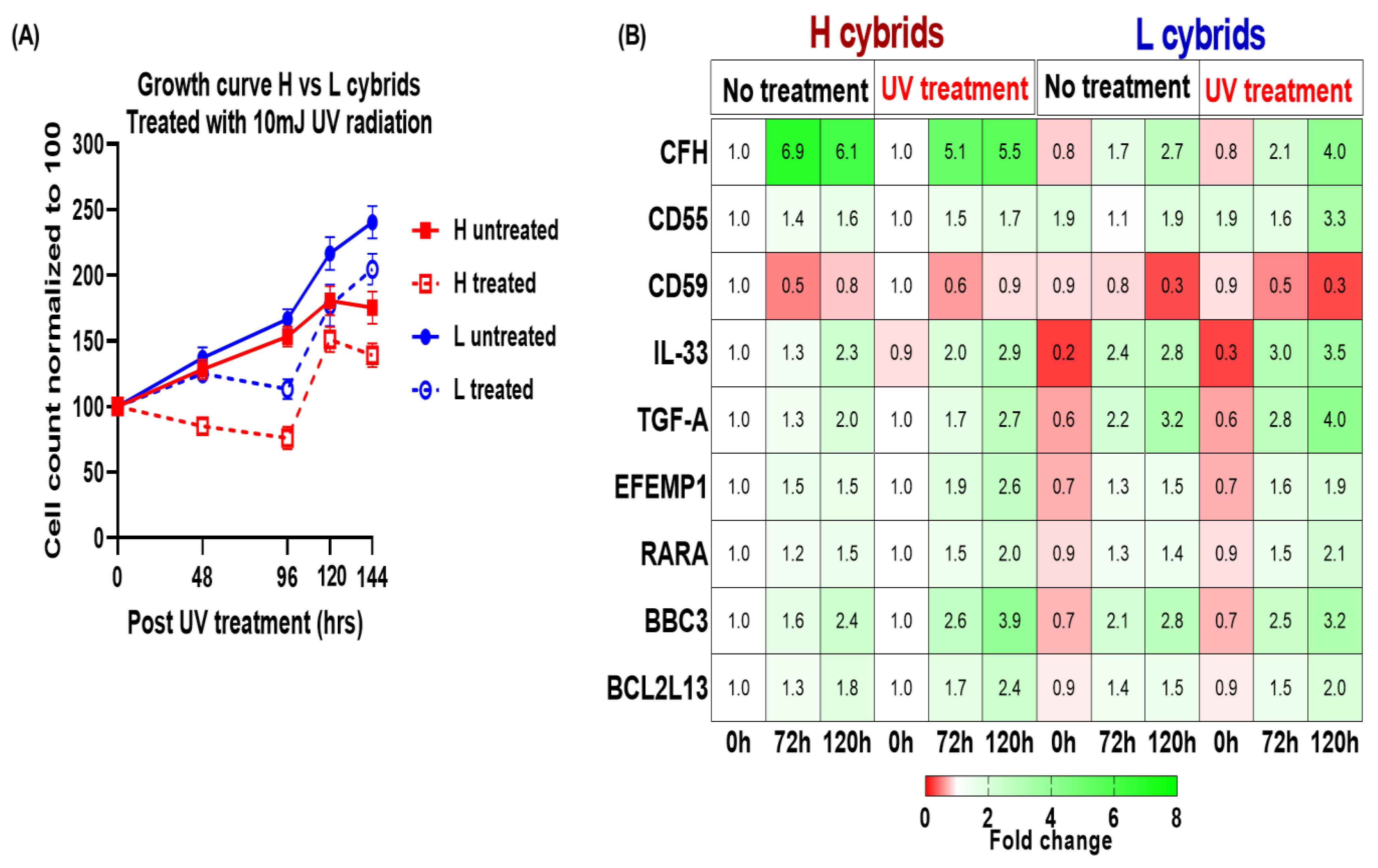
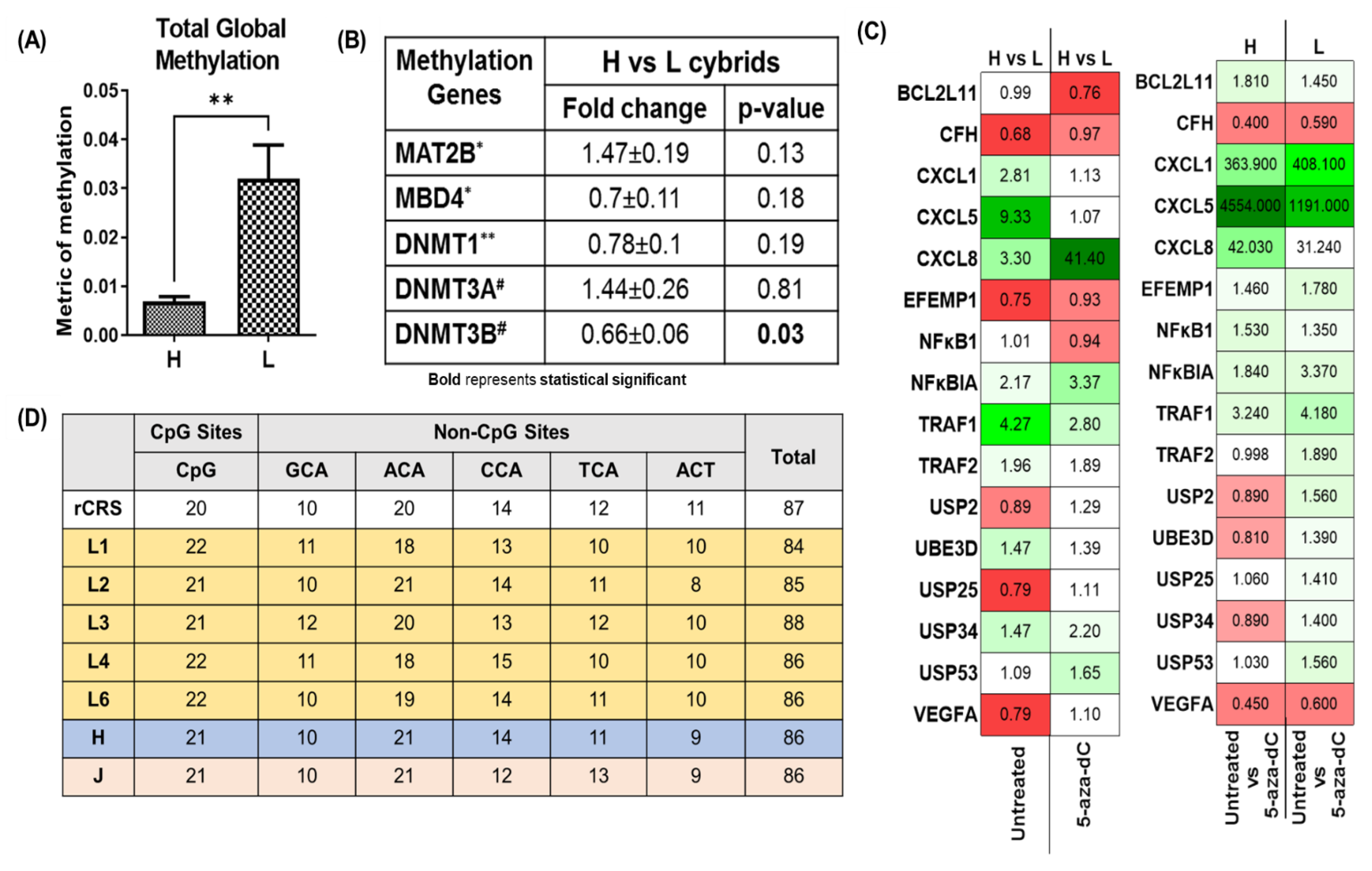
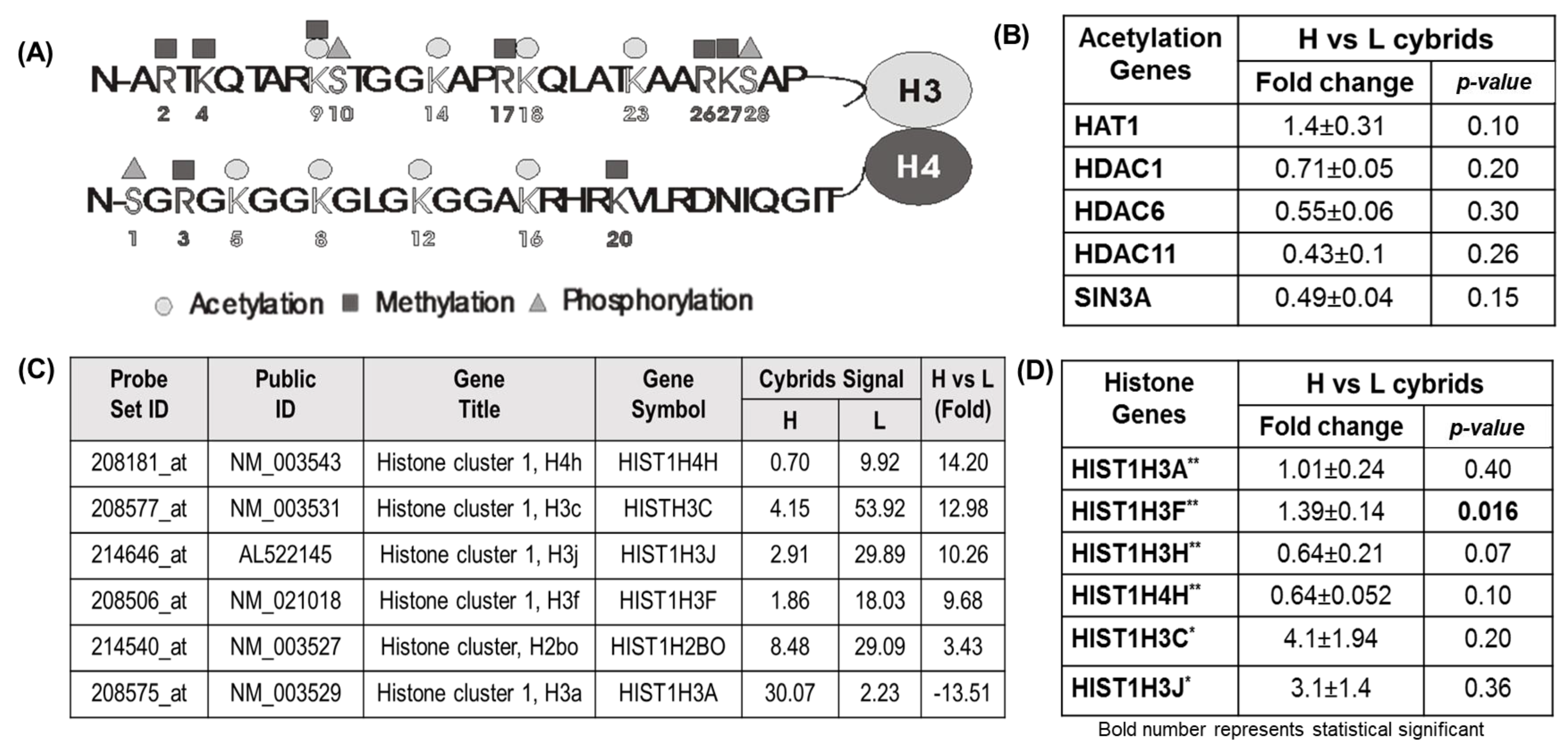
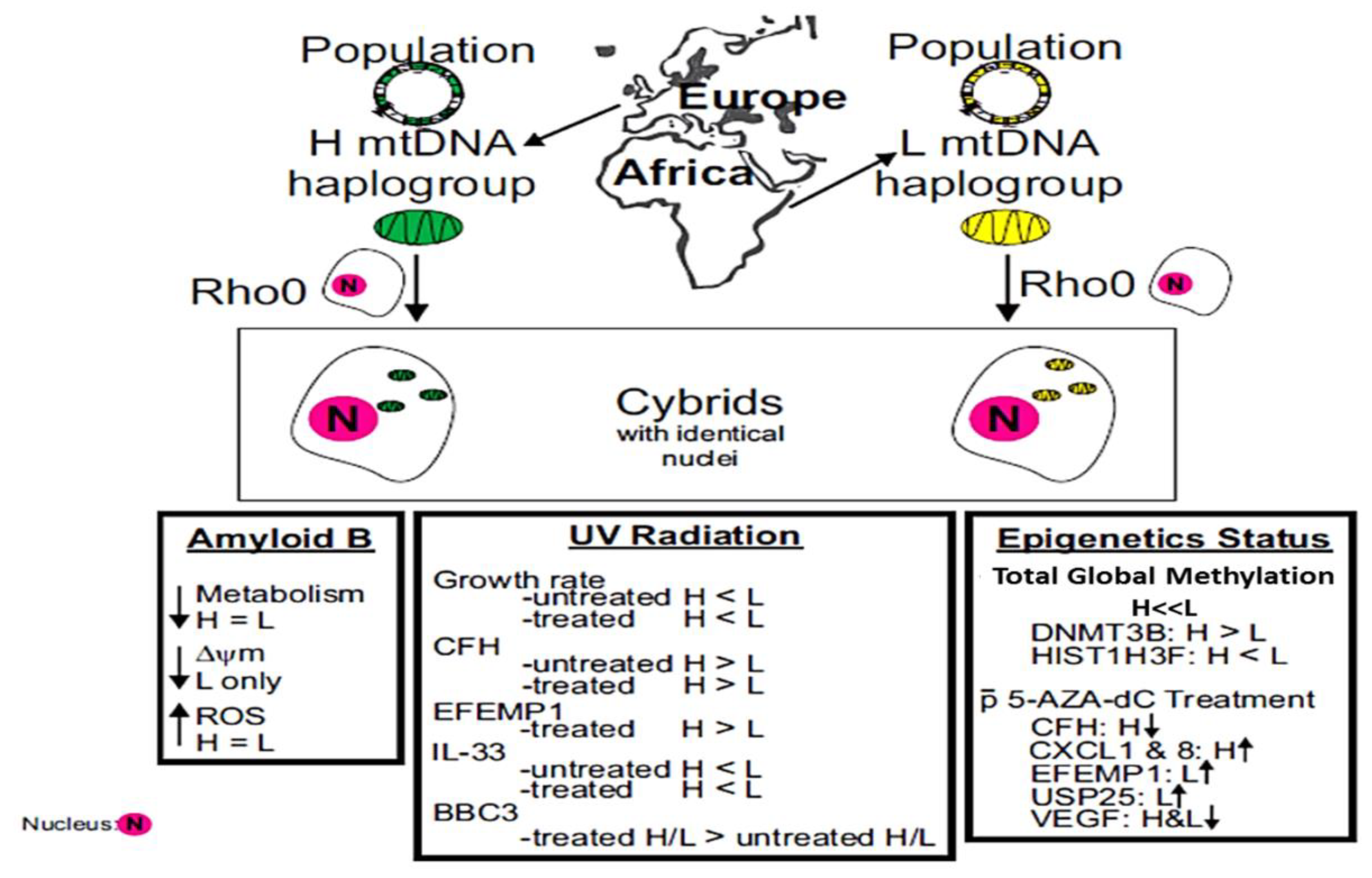
Publisher’s Note: MDPI stays neutral with regard to jurisdictional claims in published maps and institutional affiliations. |
© 2022 by the authors. Licensee MDPI, Basel, Switzerland. This article is an open access article distributed under the terms and conditions of the Creative Commons Attribution (CC BY) license (https://creativecommons.org/licenses/by/4.0/).
Share and Cite
Atilano, S.R.; Abedi, S.; Ianopol, N.V.; Singh, M.K.; Norman, J.L.; Malik, D.; Falatoonzadeh, P.; Chwa, M.; Nesburn, A.B.; Kuppermann, B.D.; et al. Differential Epigenetic Status and Responses to Stressors between Retinal Cybrids Cells with African versus European Mitochondrial DNA: Insights into Disease Susceptibilities. Cells 2022, 11, 2655. https://doi.org/10.3390/cells11172655
Atilano SR, Abedi S, Ianopol NV, Singh MK, Norman JL, Malik D, Falatoonzadeh P, Chwa M, Nesburn AB, Kuppermann BD, et al. Differential Epigenetic Status and Responses to Stressors between Retinal Cybrids Cells with African versus European Mitochondrial DNA: Insights into Disease Susceptibilities. Cells. 2022; 11(17):2655. https://doi.org/10.3390/cells11172655
Chicago/Turabian StyleAtilano, Shari R., Sina Abedi, Narcisa V. Ianopol, Mithalesh K. Singh, J Lucas Norman, Deepika Malik, Payam Falatoonzadeh, Marilyn Chwa, Anthony B. Nesburn, Baruch D. Kuppermann, and et al. 2022. "Differential Epigenetic Status and Responses to Stressors between Retinal Cybrids Cells with African versus European Mitochondrial DNA: Insights into Disease Susceptibilities" Cells 11, no. 17: 2655. https://doi.org/10.3390/cells11172655
APA StyleAtilano, S. R., Abedi, S., Ianopol, N. V., Singh, M. K., Norman, J. L., Malik, D., Falatoonzadeh, P., Chwa, M., Nesburn, A. B., Kuppermann, B. D., & Kenney, M. C. (2022). Differential Epigenetic Status and Responses to Stressors between Retinal Cybrids Cells with African versus European Mitochondrial DNA: Insights into Disease Susceptibilities. Cells, 11(17), 2655. https://doi.org/10.3390/cells11172655






